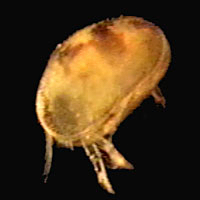
Crustaceans such as crabs and lobsters are familiar to most people. Another group of crustaceans that few people realize fall into that group are the barnacles—bizarre animals so different from crabs and lobsters that they are easily recognized as being crustaceans only by their larvae. So what does all of this have to do with the Chihuahuan Desert? Only that our native crayfish are far from our only crustaceans. Daphnia, for example, is a miniature, freshwater crustacean. They sometimes are called water fleas because their locomotion through the water resembles the jumping of fleas. They may be familiar to some because they're occasionally used as fish food in home aquariums.
A second group of aquatic crustaceans in our region consists of the ostracods. They superficially look like almost microscopic clams, having two shells concealing the rest of the animal. Since the shell fossilizes nicely and different species have different water quality requirements, former lakes of the Southwest often can be characterized by their fossil ostracods. We desert dwellers may be crabby sometimes, but it's not for lack of crustaceans.

Contributor: Arthur H. Harris, Laboratory for Environmental Biology, Centennial Museum, University of Texas at El Paso.
Desert Diary is a joint production of the Centennial Museum and KTEP National Public Radio at the University of Texas at El Paso.

Ostracod. Image courtesy of Charlie Drewes, Iowa State University.